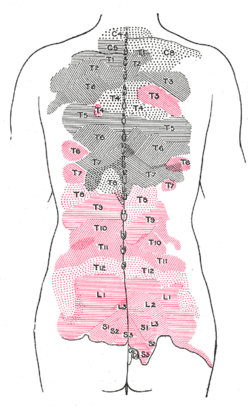Dorsal ramus of spinal nerve
| Dorsal ramus of spinal nerve | |
|---|---|

Diagram of the course and branches of a typical intercostal nerve. (Posterior division labeled at upper left.)
|
|

Areas of distribution of the cutaneous branches of the posterior divisions of the spinal nerves. The areas of the medial branches are in black, those of the lateral in red.
|
|
| Details | |
| Identifiers | |
| Latin | ramus posterior nervi spinalis |
| Dorlands /Elsevier |
r_02/12691733 |
| TA | A14.2.00.035 |
| FMA | 5983 |
|
Anatomical terms of neuroanatomy
[]
|
|
The dorsal ramus of spinal nerve (or posterior primary division) refers to the posterior division of a spinal nerve. The ramus is also known by a number of other names, "posterior (or dorsal) rami (or branches or divisions) of the spinal nerves". The dorsal ramus is one of the two major branches of a spinal nerve that emerge after the nerve emerges from the intervertebral foramen. The dorsal ramus carries information that supplies muscles and sensation to the human back.
Shortly after a spinal nerve exits the intervertebral foramen, it branches into the dorsal ramus, ventral ramus, and rami communicantes. Each of these carries both sensory and motor information. After it is formed, the posterior ramus (plural: rami) of each spinal nerve travels backward, except for the first cervical, the fourth and fifth sacral, and the coccygeal.
Posterior rami divide into medial, intermediate, and lateral branches. The lateral branch supplies innervation to the iliocostalis muscle, as well as the skin lateral to the muscle on the back. The Intermediate branch supplies innervation to the spinalis muscle and the longissimus muscle. The medial branch supplies innervation to the rest of the epaxial derived muscles on the back (including the transversospinalis muscles, intertransversarii muscles, interspinalis muscles, and splenius), and the zygapophyseal joints.
Nomina Anatomica lists dorsal primary rami as "rami dorsales" for each group of spinal nerves: 1) cervical (nervorum cervicalium ), 2) thoracic (nervorum thoracicorum ), 3) lumbar (nervorum lumbalium ), 4) sacral (nervorum sacralium ), and 5) coccygeal (nervi coccygei ).
...
Wikipedia
